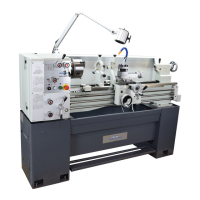15
Copyright © 2020 Quality Machine Tools, LLCPM-1440GT v9 2020-10
Figure 3-19
For all metric thread pitches lower gear is driven by the smaller (120T)
transposing gear.
Gear shifters
R-W Q-W R-W Q-W R-W Q-X Q-W Q-X
Upper
gear
28 28 42 35 49 30 49 36
A-D 3.2 4.0 4.8 5.0 5.6 6.0 7.0 7.2
B-D 1.6 2.0 2.4 2.5 2.8 3.0 3.5 3.6
A-C 0.8 1.0 1.2 1.25 1.4 1.5 1.75 1.8
B-C 0.4 0.5 9.6 0.7 0.75 0.9
Figure 3-20 Metric thread pitches (mm)
COMPOUND SETUP FOR THREAD CUTTING
Thread cutting on the lathe is unlike most other turning oper-
ations, for two reasons: 1. The cutting tool must be precisely
ground with an included angle of 60 degrees for most Amer-
ican and metric threads, and; 2. It is preferable to feed the
tool into the workpiece at an angle so it cuts mostly on the left
ank of the thread, Figure 3-21. The correct angle relative to
the cross-slide (zero degrees) is debatable — should it be 29,
29-1/2 or 30 degrees? Many machinists prefer 29 degrees be-
cause it holds the cutting tool marginally clear of the right ank
of the thread, close enough for cleanup of the ank while at the
same time avoiding appreciable rubbing.
Figure 3-21 Setting up the compound for 30
o
infeed
CUTTING PROCEDURE FOR TPI THREADS
This procedure assumes that a single point thread cutting tool
will be used, and that the threading dial assembly, Figure 3-22,
has been pivoted forward to engage its worm wheel with the
leadscrew.
The threading dial cannot used for metric threads! The
split-nut on the apron must be left engaged throughout
the entire process.
For metric and UNC/UNF threads the tool is ground to 60
o
(in-
cluded angle). It is installed so that its anks are exactly 30
o
either side of the cross axis, ideally with the compound o-
set as Figure 3-21. Single-point threads are cut in 10 or more
successive passes, each shaving a little more material o the
workpiece.
To make the rst thread-cutting pass the leadscrew is run at
the selected setting (tables on this, and preceding pages), and
the carriage is moved by hand to set the cutting tool at the
starting point of the thread. With the tool just grazing the work-
piece, the split-nut lever is lowered to engage the leadscrew.
This can be done at any point, provided the split-nut remains
engaged throughout the entire multi-pass thread cutting
process.
When the rst pass is completed, the tool is backed out clear
the workpiece (using the cross-slide), and the spindle is re-
versed to bring the saddle back to the starting point. The cross-
slide is returned to its former setting, then the tool is advanced
a few thousandths by the compound for the next pass. Each
successive pass is done in the same way, each with a slightly
increased infeed setting of the compound.
Many users working on U.S. threads save time by disengag-
ing the split-nut at the end of each cutting pass, reversing the
saddle by hand, then re-engaging, usually by reference to the
threading dial.
If the TPI number is divisible by 2 re-engagement can be done
at any line on the threading dial.
For all other TPI numbers every engagement, including the
rst, must at the point where a specic line on the threading

